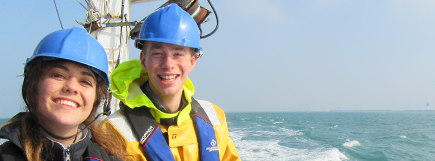Navigation
Code UE : HBB310
- Cours + travaux pratiques
- 6 crédits
- Volume horaire de référence
(+ ou - 10%) : 50 heures
Responsable(s)
Claire MARION
Objectifs pédagogiques
Module Outline:
NAVIGATION (partim 1)
CHARTS
- Describe the principal types of buoys and beacons, and their roles as aids to navigation
- Explain the function of radio and radar beacons.
- Describe the use of traffic separation schemes
- Explain the relationship of Notice to Mariners to nautical charts and publications, and describe the mariner's responsibility to provide information for inclusion in Notice to Mariners
- Interpret navigational warnings and Notice to Mariners
- Apply Notice to Mariners chart corrections to a nautical chart
- Explain the different uses of the nautical chart
- Classify nautical charts according to scale, objectives, edition, and form (paper - digital)
Describe the content of a nautical chart.
- Differentiate special purpose nautical charts
- Use nautical chart for various applications
- Recognize common charting symbols
- Explain the following components of a nautical chart: datum, projection, scale
- Describe the ENC and ECDIS standards, as well as raster nautical chart standards
- Describe other Electronic Chart Systems (ECS) and formats
- Explain the differences between these electronic charting products
- Describe the ENC production process
- Describe the source and content of sailing directions, light and radio lists, and tide and current tables
COLREG (partim 1)
- explanation of the rules of the road
- recognize which vessel should keep clear of the other vessel, in a variety of meeting, crossing, and overtaking situations
- Recognize the lights and day shapes displayed by common vessel types
- Describe the sound signals required when operating in reduced visibility
- Explain the responsibilities of a vessel operating in reduced visibility
INSTRUMENTS (partim 1)
- Describe the capabilities and limitations of magnetic and gyro compasses
- Explain the sources of magnetic and gyro compass error
- Determine and apply corrections for magnetic and gyro compass error
- basic principles of a sextant and its use
- errors of sextant and sextant observations
NAVIGATION
- comparison of horizontal and equatorial coordinates in order to create the geocentrical sphere (navigation triangle)
- be able to determine a fix (position) by sextant and pelorus
- Explain the role of pilots for ships entering port
- Describe the responsibilities of the pilot and the vessel master when a pilot is aboard
MODULE 3
NAVIGATION (partim 2)
COLREG (partim 2)
- case studies of COLREG
INSTRUMENTS (partim 2)
- Explain the basic principles of radar operation, and describe the capabilities and limitations of radar
- Explain the basic principles of ARPA operation, and describe the capabilities and limitations of radar
MANOEUVRES
- Describe the manoeuvring capabilities of single and twin screw ships, as well as ships with bow thrusters and omni directional drive systems
- Explain how tows will handle at varying speeds and with varying amounts of tow line
- Describe the component parts of shipboard ground tackle (anchor, chain, windlass, stoppers, etc.)
- Describe how multiple anchors can be used to position a vessel over a fixed location
- Explain how the final position of the vessel can be adjusted
- Demonstrate the ability to manoeuvre a small boat
- Draw a diagram showing how an anchor should be rigged on a small boat
METEOROLOGY & OCEANOGRAPHY
- Description of the vertical structure of the atmosphere
- Definition of the following parameters and explanation on how they are measured/classified and what their effect on hydrographic operations is: temperature, humidity, dew-point, frost-point, atmospheric pressure, fog, clouds and precipitation, rain, snow, visibility
- Explanation of the relation between atmospheric pressure and winds
- The origin of geostrophic winds and Guy Ballot's law
- Description of wind circulation around pressure systems
- The effect of friction
- Operate instruments and sensors used to register temperatures pressure, direction and intensity of wind
- Identification of characteristics of weather by simple observation of the sea and the sky
- Recording meteorological parameters according to internationally accepted standards
- Synoptic weather charts
- Weather forecast based on synoptic charts
- Definition of salinity, conductivity, temperature, pressure, density and colour
- Description of the relationship between temperature and salinity in relation to depth
- Wind-waves and swell
- Definition of wave parameters
- Explanation of the elements involved in the wave growth process including typical fetches
- Classification of sea state according to Beaufort Scale
- Wave propagation
- Definition and practical examples of refraction, diffraction and reflection
- Explanation of breaking waves and long-shore and rip current processes
NAVIGATION (partim 1)
CHARTS
- Describe the principal types of buoys and beacons, and their roles as aids to navigation
- Explain the function of radio and radar beacons.
- Describe the use of traffic separation schemes
- Explain the relationship of Notice to Mariners to nautical charts and publications, and describe the mariner's responsibility to provide information for inclusion in Notice to Mariners
- Interpret navigational warnings and Notice to Mariners
- Apply Notice to Mariners chart corrections to a nautical chart
- Explain the different uses of the nautical chart
- Classify nautical charts according to scale, objectives, edition, and form (paper - digital)
Describe the content of a nautical chart.
- Differentiate special purpose nautical charts
- Use nautical chart for various applications
- Recognize common charting symbols
- Explain the following components of a nautical chart: datum, projection, scale
- Describe the ENC and ECDIS standards, as well as raster nautical chart standards
- Describe other Electronic Chart Systems (ECS) and formats
- Explain the differences between these electronic charting products
- Describe the ENC production process
- Describe the source and content of sailing directions, light and radio lists, and tide and current tables
COLREG (partim 1)
- explanation of the rules of the road
- recognize which vessel should keep clear of the other vessel, in a variety of meeting, crossing, and overtaking situations
- Recognize the lights and day shapes displayed by common vessel types
- Describe the sound signals required when operating in reduced visibility
- Explain the responsibilities of a vessel operating in reduced visibility
INSTRUMENTS (partim 1)
- Describe the capabilities and limitations of magnetic and gyro compasses
- Explain the sources of magnetic and gyro compass error
- Determine and apply corrections for magnetic and gyro compass error
- basic principles of a sextant and its use
- errors of sextant and sextant observations
NAVIGATION
- comparison of horizontal and equatorial coordinates in order to create the geocentrical sphere (navigation triangle)
- be able to determine a fix (position) by sextant and pelorus
- Explain the role of pilots for ships entering port
- Describe the responsibilities of the pilot and the vessel master when a pilot is aboard
MODULE 3
NAVIGATION (partim 2)
COLREG (partim 2)
- case studies of COLREG
INSTRUMENTS (partim 2)
- Explain the basic principles of radar operation, and describe the capabilities and limitations of radar
- Explain the basic principles of ARPA operation, and describe the capabilities and limitations of radar
MANOEUVRES
- Describe the manoeuvring capabilities of single and twin screw ships, as well as ships with bow thrusters and omni directional drive systems
- Explain how tows will handle at varying speeds and with varying amounts of tow line
- Describe the component parts of shipboard ground tackle (anchor, chain, windlass, stoppers, etc.)
- Describe how multiple anchors can be used to position a vessel over a fixed location
- Explain how the final position of the vessel can be adjusted
- Demonstrate the ability to manoeuvre a small boat
- Draw a diagram showing how an anchor should be rigged on a small boat
METEOROLOGY & OCEANOGRAPHY
- Description of the vertical structure of the atmosphere
- Definition of the following parameters and explanation on how they are measured/classified and what their effect on hydrographic operations is: temperature, humidity, dew-point, frost-point, atmospheric pressure, fog, clouds and precipitation, rain, snow, visibility
- Explanation of the relation between atmospheric pressure and winds
- The origin of geostrophic winds and Guy Ballot's law
- Description of wind circulation around pressure systems
- The effect of friction
- Operate instruments and sensors used to register temperatures pressure, direction and intensity of wind
- Identification of characteristics of weather by simple observation of the sea and the sky
- Recording meteorological parameters according to internationally accepted standards
- Synoptic weather charts
- Weather forecast based on synoptic charts
- Definition of salinity, conductivity, temperature, pressure, density and colour
- Description of the relationship between temperature and salinity in relation to depth
- Wind-waves and swell
- Definition of wave parameters
- Explanation of the elements involved in the wave growth process including typical fetches
- Classification of sea state according to Beaufort Scale
- Wave propagation
- Definition and practical examples of refraction, diffraction and reflection
- Explanation of breaking waves and long-shore and rip current processes
Compétences visées
Basic knowledge of all subjects, methodology and their practice. The aim of the course is also to convey to those students with a limited meteorological and oceanographic background as well as an insight in meteorological processes (atmosphere, wind, weather) and oceanographic processes (wind-waves and swell, wind propagation, physical properties of the sea water).
Contenu
Lecture 1 Charts (partim 1)
Chart datum and introduction to nautical charts.
Reference ellipsoids used on nautical chart.
Projections and types of nautical charts
Lecture 2 ColReg (partim 1)
Introduction to the Collision Avoidance Rules
Difference between inland navigation Rules and the rules at sea.
Identification of different kinds of vessels.
Lecture 3 ColReg (partim 1)
Identification of different kinds of vessels at night.
Navigation rules.
Behaviour in reduced visibility
Lecture 4 Charts (partim 1)
Symbols and abbreviations used on admiralty paper and electronic charts.
Production of paper and electronic charts
Accuracy indication of paper and digital charts.
Plotting a position on a chart and layout of a voyage.
Different admiralty publications and their use.
Lecture 5 Navigation (partim 1)
Lecture 6 ColReg (partim 1)
Recognize which vessel should keep clear of the other vessel , in a variety of meeting, crossing, and overtaking situations.
Aids to navigation
Basics about automatic identification systems
Different types of buoys and beacons, IALA A and B
Radar beacons and RACON
Lecture 7 Instruments
The use of magnetic and gyro compasses, application of variation and deviation
The use of a sextant. Study on the errors and calibration of a sextant.
Lecture 8 Navigation (partim 1)
Putting positions on a chart with compass bearing and horizontal angle measurement by sextant
The role of a pilot on board a vessel and the use of pilot charts and ppu’s.
Examination 1 Examination about the content of lecture 1 to 8
Lecture 9 Manoeuvres
Manoeuvring with a single screw vessel and a twin screw vessel.
Manoeuvring with small boats
Lecture 10 Meteorology
Description of the vertical structure of the atmosphere
Explanation about : temperature, humidity, dew-point, frost-point, atmospheric pressure, fog, clouds and precipitation, rain, snow and visibility.
Beaufort scale.
Lecture 11 Meteorology
Relationship between atmospheric pressure and wind, the origin of geostrophic wind and the law of Guy Ballot.
Explanation of wind circulation around pressure systems
The effect of friction on wind.
The study of a synoptic weather charts an producing a weather forecast based on synoptic charts.
Lecture 12 Radar and ARPA, working principles.
Positioning with Radar bearings and distance measurement.
Limitations of Radar
Using ARPA for collision avoidance
Lecture 13 Collision regulations
Case studies
Lecture 14 Anchoring and towing
Study of the ground tackle used on small boats.
Exercises on manoeuvring when towing objets.
Technics for instrument moorings.
Lecture 15 Oceanography 1
Definition of salinity, Conductivity, temperature, pressure, density and colour and the instruments needed to measure these parameters.
Calibration of the instruments.
Study of the relationship between temperature and salinity in relation to depth
Lecture 16 Oceanography 2
Study of wind, waves and swell.
Definition of wave parameters.
Explanation of the elements involved in the wave growth process including typical fetches.
Classification of sea state according to Beaufort Scale.
Wave propagation.
Definition and practical examples of refraction, diffraction and reflection.
Explanation of breaking waves and long-shore and rip current processes.
Examination 2 Examination about the contents of Lecture 9 to 16
Chart datum and introduction to nautical charts.
Reference ellipsoids used on nautical chart.
Projections and types of nautical charts
Lecture 2 ColReg (partim 1)
Introduction to the Collision Avoidance Rules
Difference between inland navigation Rules and the rules at sea.
Identification of different kinds of vessels.
Lecture 3 ColReg (partim 1)
Identification of different kinds of vessels at night.
Navigation rules.
Behaviour in reduced visibility
Lecture 4 Charts (partim 1)
Symbols and abbreviations used on admiralty paper and electronic charts.
Production of paper and electronic charts
Accuracy indication of paper and digital charts.
Plotting a position on a chart and layout of a voyage.
Different admiralty publications and their use.
Lecture 5 Navigation (partim 1)
Lecture 6 ColReg (partim 1)
Recognize which vessel should keep clear of the other vessel , in a variety of meeting, crossing, and overtaking situations.
Aids to navigation
Basics about automatic identification systems
Different types of buoys and beacons, IALA A and B
Radar beacons and RACON
Lecture 7 Instruments
The use of magnetic and gyro compasses, application of variation and deviation
The use of a sextant. Study on the errors and calibration of a sextant.
Lecture 8 Navigation (partim 1)
Putting positions on a chart with compass bearing and horizontal angle measurement by sextant
The role of a pilot on board a vessel and the use of pilot charts and ppu’s.
Examination 1 Examination about the content of lecture 1 to 8
Lecture 9 Manoeuvres
Manoeuvring with a single screw vessel and a twin screw vessel.
Manoeuvring with small boats
Lecture 10 Meteorology
Description of the vertical structure of the atmosphere
Explanation about : temperature, humidity, dew-point, frost-point, atmospheric pressure, fog, clouds and precipitation, rain, snow and visibility.
Beaufort scale.
Lecture 11 Meteorology
Relationship between atmospheric pressure and wind, the origin of geostrophic wind and the law of Guy Ballot.
Explanation of wind circulation around pressure systems
The effect of friction on wind.
The study of a synoptic weather charts an producing a weather forecast based on synoptic charts.
Lecture 12 Radar and ARPA, working principles.
Positioning with Radar bearings and distance measurement.
Limitations of Radar
Using ARPA for collision avoidance
Lecture 13 Collision regulations
Case studies
Lecture 14 Anchoring and towing
Study of the ground tackle used on small boats.
Exercises on manoeuvring when towing objets.
Technics for instrument moorings.
Lecture 15 Oceanography 1
Definition of salinity, Conductivity, temperature, pressure, density and colour and the instruments needed to measure these parameters.
Calibration of the instruments.
Study of the relationship between temperature and salinity in relation to depth
Lecture 16 Oceanography 2
Study of wind, waves and swell.
Definition of wave parameters.
Explanation of the elements involved in the wave growth process including typical fetches.
Classification of sea state according to Beaufort Scale.
Wave propagation.
Definition and practical examples of refraction, diffraction and reflection.
Explanation of breaking waves and long-shore and rip current processes.
Examination 2 Examination about the contents of Lecture 9 to 16
Modalité d'évaluation
- Contrôle continu
- Examen final
Cette UE apparaît dans les diplômes et certificats suivants
Rechercher une formation
CRITERES
- Le champ Mot-clé permet de rechercher les formations grâce à un mot ou à une expression présent dans l’intitulé ou dans les index d’une formation.
Des index vous sont suggérés à partir du 3e caractère saisi, mais vous pouvez aussi saisir librement tout autre chaîne de caractères . - les différents items sélectionnés sont croisés.
ex: "Comptabilité" et "Région Alsace"
CODE
- Vous pouvez utiliser le caractère joker * pour remplacer un nombre quelconque de caractères
- UE : le code comprend 3 lettres immédiatement suivies de 3 chiffres
- Certificat : le code comprend 2 ou 3 lettres immédiatement suivies de 3 chiffres. Certains certificats se déclinent selon plusieurs parcours :
- pour afficher le tronc commun, tapez le code simple (ex : LG005).
- pour afficher un parcours précis dans un diplôme, faites suivre le code de la lettre "p", et du numéro de parcours (ex : LG005p2). Si le diplôme ne comporte qu'un seul parcours, faites suivre la lettre "p" de -1 (ex : CYC17p-1).
Dans tous les cas, veillez à ne pas insérer d'espace ou de ponctuation supplémentaire.
Chargement du résultat...

Intitulé de la formation |
Type |
Modalité(s) |
Lieu(x) |
|
|---|---|---|---|---|
Intitulé de la formation
Bachelor océanographe prospecteur
|
Lieu(x)
Initial
|
Lieu(x)
Paris
|
||
| Intitulé de la formation | Type | Modalité(s) | Lieu(x) |
Contact
Voir le calendrier, le tarif, les conditions d'accessibilité et les modalités d'inscription dans le(s) centre(s) d'enseignement qui propose(nt) cette formation.
Enseignement non encore programmé
Code UE : HBB310
- Cours + travaux pratiques
- 6 crédits
- Volume horaire de référence
(+ ou - 10%) : 50 heures
Responsable(s)
Claire MARION












